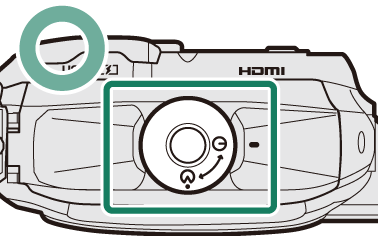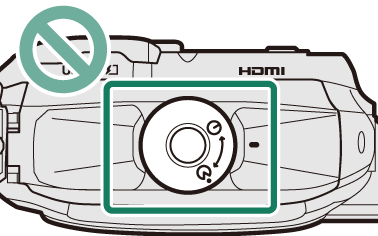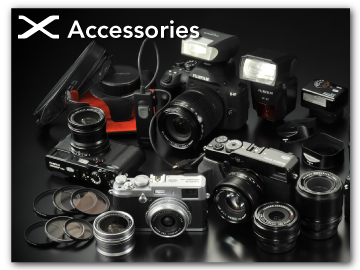Inserting the Battery and a Memory Card
Insert the battery and memory card as described below.
Before proceeding, confirm that the water-resistant seal is free of foreign matter as described on “Before Use”.
-
Open the battery-chamber cover.
Keeping the safety lock pressed (A), rotate the latch (B) and open the battery-chamber cover (C).
Remove water droplets and other foreign matter with a dry cloth before opening the battery-chamber cover.
Do not open the battery-chamber cover when the camera is on. Failure to observe this precaution could result in damage to image files or memory cards.
Do not use excessive force when handling the battery-chamber cover.
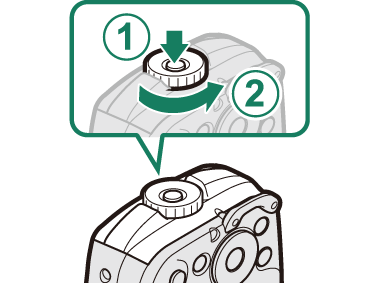
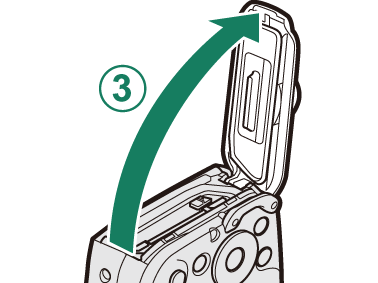
-
Insert the battery as shown.
Using the battery to keep the battery latch pressed to one side, insert the battery contacts first in the direction shown by the arrow.
Inserting the battery in the incorrect orientation could damage the camera. Be sure to insert the battery in the correct orientation.
Confirm that the battery is securely latched.

-
Insert the memory card.
Be sure card is in the correct orientation; do not insert at an angle or use force. If the memory card is not correctly inserted or no memory card is inserted, a will appear in the LCD monitor and internal memory will be used for recording and playback.
Holding the card in the orientation shown, slide it in until it clicks into place at the back of the slot.
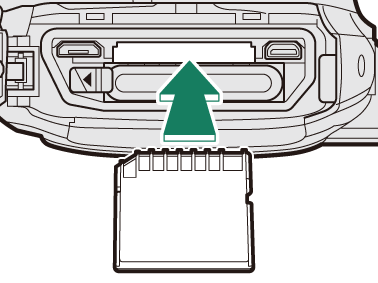
-
Holding the battery-chamber cover closed against the camera body (A), rotate the latch until it clicks into place (B), indicating that the cover is secure.
If the cover does not close, check that the battery is in the correct orientation.
Before closing the cover, confirm that there is no dust, sand, or other foreign matter on the water-resistant seal or adjacent surfaces.
When closing the battery-chamber cover, do not subject it to excessive horizontal forces. Failure to observe this precaution could cause the water-resistant seal to become misaligned, allowing water into the camera.
Check that the cover is secure by rotating the latch in the opposite direction and confirming that the cover does not open.
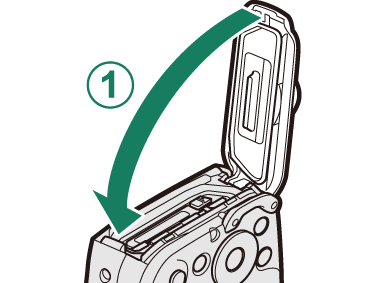

-
Format the memory card (a [FORMAT]).
Format memory cards before first use, and be sure to reformat all memory cards after using them in a computer or other device.
Confirming That the Cover Is Latched
Make sure that the strap is not caught in the cover.

Confirm that the latch is closed.
Removing the Battery and Memory Card
Before removing the battery or memory card, turn the camera off and open the battery-chamber cover.
To remove the battery, press the battery latch to the side, and slide the battery out of the camera as shown.
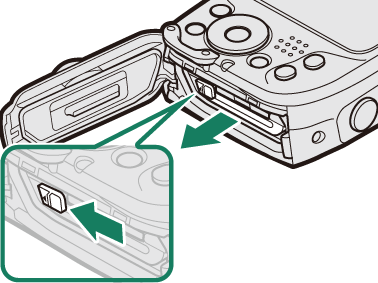
The battery may become hot when used in high-temperature environments. Observe caution when removing the battery.
To remove the memory card, press it in and release it slowly. The card can then be removed by hand. When a memory card is removed, the card could be ejected too quickly. Use your finger to hold it and gently release the card.

Press the center of the card when ejecting it.
Compatible Memory Cards
- The camera can be used with SD, SDHC, and SDXC memory cards. The UHS-I bus interface is supported.
- Use a memory card with a UHS speed class of 3 or better for 4K burst photography or when recording movies.
- A list of supported memory cards is available on the Fujifilm website. For details, visit: a Compatibility.
Do not turn the camera off or remove the memory card while the memory card is being formatted or data are being recorded to or deleted from the card. Failure to observe this precaution could damage the card.
Memory cards can be locked, making it impossible to format the card or to record or delete images. Before inserting a memory card, slide the write-protect switch to the unlocked position.
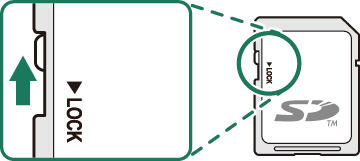
Memory cards are small and can be swallowed; keep out of reach of children. If a child swallows a memory card, seek medical assistance immediately.
miniSD or microSD adapters that are larger or smaller than memory cards may not eject normally; if the card does not eject, take the camera to an authorized service representative. Do not forcibly remove the card.
Do not affix labels or other objects to memory cards. Peeling labels can cause camera malfunction.
Movie recording may be interrupted with some types of memory card.
The data in internal memory may be erased or corrupted when the camera is repaired. Please note that the repairer will be able to view pictures in internal memory.
With the first shot taken after a memory card or internal memory is formatted in the camera, the camera creates a folder in which pictures are stored. Do not rename or delete this folder or use a computer or other device to edit, delete, or rename image files. Always use the camera to delete pictures from memory cards and internal memory; before editing or renaming files, copy them to a computer and edit or rename the copies, not the originals. Renaming the files on the camera can cause problems during playback.

 .
.